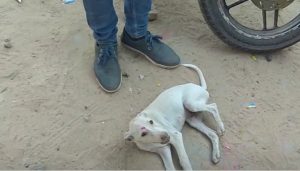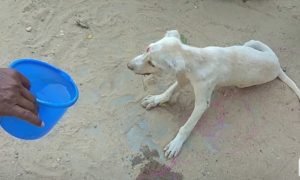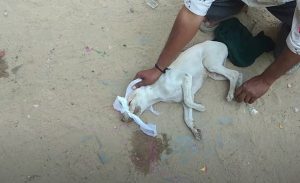In a peaceful neighborhood, the distressed cries of a dog could be heard, causing concern and alarm among onlookers. Despite showing no visible injuries, suspicions arose that the canine might be suffering from rabies, a dreaded viral disease. The dog remained unaware of the bystanders’ genuine intentions to assist, as its apprehension was so profound that no one dared to approach and touch it. This only added to the mystery surrounding its condition.

It became evident that the dog was suffering from hydrophobia, a distressing symptom of rabies. As the story unfolds, we delve into the dog’s difficult journey towards recovery, highlighting the efforts made by veterinary professionals and the community to alleviate its suffering.

The dog displayed a constant screaming behavior that conveyed a deep sense of distress. Despite refraining from attempting to bite anyone, its profound shock and fear were palpable. Unfortunately, these emotions prevented the dog from recognizing the benevolent intentions of those present. As the situation unfolded, it became apparent that the dog had developed an intense aversion to all forms of liquids, a classic symptom of hydrophobia.

After consulting with a veterinarian, it was determined that the dog was in the initial stage of hydrophobia, which is a manifestation of rabies. Despite what many people believe, hydrophobia is not just a fear of water. It actually encompasses the excruciating pain associated with ingesting any form of liquid. The dog exhibited uncontrollable restlessness and darted around in a desperate attempt to escape from its perceived torment even at the sight of liquids or water.

Due to the potential danger posed by a dog exhibiting such symptoms, immediate action was necessary to ensure the safety of both the animal and the community. Recognizing the need to protect others from possible bites, the decision was made to temporarily secure the dog’s mouth. This precautionary measure aimed to prevent any accidental harm while facilitating the subsequent steps towards treatment and recovery.
To combat hydrophobia, the veterinarian administered vaccines specifically tailored to address the rabies virus. These vaccines, while not providing an instant cure, are known to boost the dog’s immune system, improving its chances of recovery. Additionally, the dog received a course of antibiotics to address any potential infections and vitamin injections to enhance its overall well-being.

After providing initial treatment, the dog was transferred to an animal hospital where it could receive specialized care and continued medical attention. The veterinary professionals at the hospital possess the necessary expertise and resources to closely monitor the dog’s progress. Through diligent observation and ongoing treatment, they aim to alleviate the dog’s suffering and increase its chances of survival.

The harrowing tale of a dog afflicted with hydrophobia rabies sheds light on the devastating impact of this viral disease. The dog’s screams and fearful behavior serve as a poignant reminder of the immense suffering experienced by animals in such circumstances. Nevertheless, the efforts made by veterinary professionals and the community exemplify the collective empathy and determination to help those in need. As the dog continues its arduous journey towards recovery, it is our hope that its story serves as a rallying cry for increased awareness and compassionate action in the face of such heart-wrenching situations.
